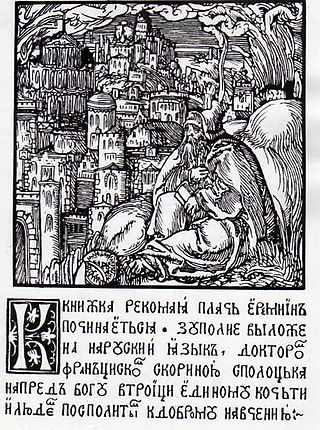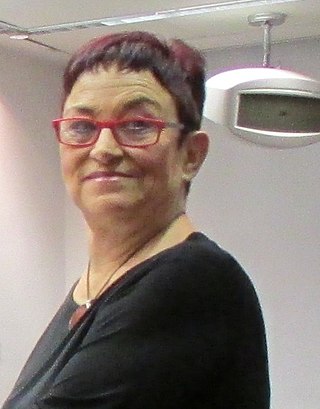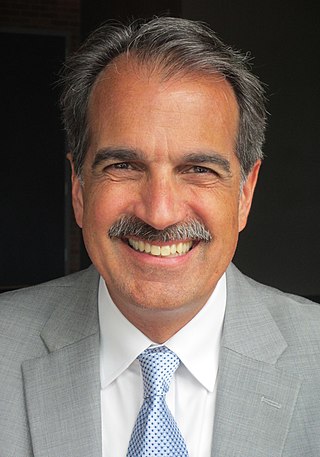
The Bible is a collection of religious texts or scriptures, some, all, or a variant of which are held to be sacred in Christianity, Judaism, Samaritanism, Islam, the Baháʼí Faith, and other Abrahamic religions. The Bible is an anthology originally written in Hebrew, Aramaic, and Koine Greek. The texts include instructions, stories, poetry, prophecies, and other genres. The collection of materials that are accepted as part of the Bible by a particular religious tradition or community is called a biblical canon. Believers in the Bible generally consider it to be a product of divine inspiration, but the way they understand what that means and interpret the text varies.

The Book of Judges is the seventh book of the Hebrew Bible and the Christian Old Testament. In the narrative of the Hebrew Bible, it covers the time between the conquest described in the Book of Joshua and the establishment of a kingdom in the Books of Samuel, during which Biblical judges served as temporary leaders.
The Book of Proverbs is a book in the third section of the Hebrew Bible traditionally ascribed to King Solomon and his students later appearing in the Christian Old Testament. When translated into Greek and Latin, the title took on different forms: in the Greek Septuagint (LXX) it became Παροιμίαι ; in the Latin Vulgate the title was Proverbia, from which the English name is derived.

The Book of Lamentations is a collection of poetic laments for the destruction of Jerusalem in 586 BCE. In the Hebrew Bible, it appears in the Ketuvim ("Writings") as one of the Five Megillot alongside the Song of Songs, Book of Ruth, Ecclesiastes, and the Book of Esther. In the Christian Old Testament, it follows the Book of Jeremiah as the prophet Jeremiah is traditionally understood to have been its author.

The documentary hypothesis (DH) is one of the models used by biblical scholars to explain the origins and composition of the Torah. A version of the documentary hypothesis, frequently identified with the German scholar Julius Wellhausen, was almost universally accepted for most of the 20th century. It posited that the Pentateuch is a compilation of four originally independent documents: the Jahwist, Elohist, Deuteronomist, and Priestly sources, frequently referred to by their initials. The first of these, J, was dated to the Solomonic period. E was dated somewhat later, in the 9th century BCE, and D was dated just before the reign of King Josiah, in the 7th or 8th century BCE. Finally, P was generally dated to the time of Ezra in the 5th century BCE. The sources would have been joined at various points in time by a series of editors or "redactors".
The historicity of the Bible is the question of the Bible's relationship to history—covering not just the Bible's acceptability as history but also the ability to understand the literary forms of biblical narrative. Questions on biblical historicity are typically separated into evaluations of whether the Old Testament and Hebrew Bible accurately record the history of ancient Israel and Judah and the second Temple period, and whether the Christian New Testament is an accurate record of the historical Jesus and of the Apostolic Age. This tends to vary depending upon the opinion of the scholar.

Biblical criticism is the use of critical analysis to understand and explain the Bible without appealing to the supernatural. During the eighteenth century, when it began as historical-biblical criticism, it was based on two distinguishing characteristics: (1) the scientific concern to avoid dogma and bias by applying a neutral, non-sectarian, reason-based judgment to the study of the Bible, and (2) the belief that the reconstruction of the historical events behind the texts, as well as the history of how the texts themselves developed, would lead to a correct understanding of the Bible. This sets it apart from earlier, pre-critical methods; from the anti-critical methods of those who oppose criticism-based study; from the post-critical orientation of later scholarship; and from the multiple distinct schools of criticism into which it evolved in the late twentieth and early twenty-first centuries.
Robert Bernard Alter is an American professor of Hebrew and comparative literature at the University of California, Berkeley, where he has taught since 1967. He published his translation of the Hebrew Bible in 2018.
Hebrew Bible English translations are English translations of the Hebrew Bible (Tanakh) according to the Masoretic Text, in the traditional division and order of Torah, Nevi'im, and Ketuvim. Most Jewish translations appear in bilingual editions (Hebrew–English).

In the Hebrew Bible, the coat of many colors or ketonet passim is the name for the garment that the Biblical Joseph owned; it was given to him by his father Jacob in Vayeshev.

The Judgement of Solomon is a story from the Hebrew Bible in which Solomon ruled between two women who both claimed to be the mother of a child. Solomon ordered the baby be cut in half, with each woman to receive one half. The first woman accepted the compromise as fair, but the second begged Solomon to give the baby to her rival, preferring the baby to live, even without her. Solomon ordered the baby given to the second woman, as her love was selfless, as opposed to the first woman's selfish disregard for the baby's actual well-being. Some consider this approach to justice an archetypal example of an impartial judge displaying wisdom in making a ruling.
Biblical minimalism, also known as the Copenhagen School because two of its most prominent figures taught at Copenhagen University, is a movement or trend in biblical scholarship that began in the 1990s with two main claims:
- that the Bible cannot be considered reliable evidence for what had happened in ancient Israel; and
- that "Israel" itself is a problematic subject for historical study.
A type scene is a literary convention employed by a narrator across a set of scenes, or related to scenes already familiar to the audience. The similarities with, and differences from, the established type are used to illuminate developments in plot and character. Robert Louis Fowler wrote, "The technique of the type-scene offers the poet a basic scaffolding, but it also allows the poet to adapt each scene for specific purposes."
Adele Berlin is an American biblical scholar and Hebraist. Before her retirement, she was Robert H. Smith Professor of Biblical Studies at the University of Maryland.

Yairah Amit is an Israeli biblical scholar. Amit studied at the Hebrew University of Jerusalem before doing a PhD at Tel Aviv University under the supervision of Meir Sternberg. She is currently Professor of Biblical Studies at Tel Aviv University. In 2012 a Festschrift was published in her honor. Words, Ideas, Worlds: Biblical Essays in Honour of Yairah Amit (ISBN 1-90753-450-4) included contributions from Athalya Brenner, Cheryl Exum, and Yael Feldman.
Danna Nolan Fewell is an Old Testament scholar. She is John Fletcher Hurst Professor of Hebrew Bible at Drew University Theological School.

Shimon Bar-Efrat (1929–2010) was an Israeli Old Testament scholar. He was Head of Biblical Studies at the Hebrew University Secondary School in Jerusalem, and is best known for his book, Narrative Art in the Bible, in which he "provides a catalogue of literary techniques and devices found in Old Testament narratives." Jeffrey Staley suggests that, along with Robert Alter, Adele Berlin, and Meir Sternberg, Bar-Efrat is a master of "leading the reader through the sudden twists and sharp turns, the steep ridges and dizzying drop-offs that make up the art of ancient Hebrew characterization."

Gary A. Rendsburg is a professor of biblical studies, Hebrew language, and ancient Judaism at Rutgers University in New Brunswick, New Jersey. He holds the rank of Distinguished Professor and serves as the Blanche and Irving Laurie Chair of Jewish History at Rutgers University (2004–present), with positions in the Department of Jewish Studies and the Department of History.

The Art of Biblical Narrative is a 1981 book by Robert Alter in which he outlines a literary approach to the Hebrew Bible. He proposes that "the Bible in its final form constitutes an artistic document with a full texture of interconnected unity."
The composition of the Torah was a process that involved multiple authors over an extended period of time. While Jewish tradition holds that all five books were originally written by Moses sometime in the 2nd millennium BCE, leading scholars have rejected Mosaic authorship since the 17th century.










